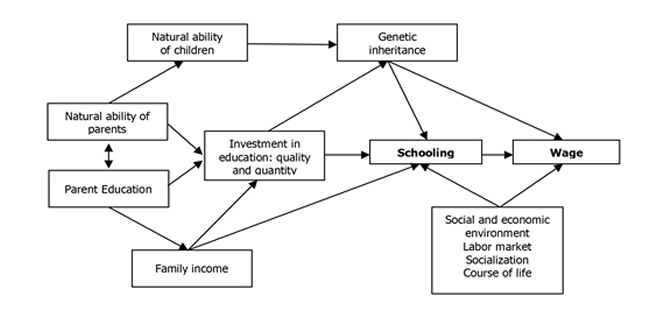
doi.org/10.15198/seeci.2019.48.87-108
RESEARCH
RELATIONSHIP BETWEEN SCHOOLING AND INCOME UNDER THE PERSPECTIVE OF THE THEORY OF HUMAN CAPITAL. CASE STUDY
RELACIÓN DEL GRADO DE ESCOLARIDAD Y EL INGRESO BAJO LA PERSPECTIVA DE LA TEORÍA DEL CAPITAL HUMANO. ESTUDIO DE CASO
RELAÇÃO DE GRAU DE ESCOLARIDADE E O INGRESSO SOB A PERSPECTIVA DA TEORIA DO CAPITAL HUMANO. ESTUDO DO CASO
Javier Jiménez Rodríguez1, Rosario Cota Yáñez1
1University of Guadalajara. México.
ABSTRACT
This document analyzes the variables in the determination of the income of the workers of a spare parts retailer in the metropolitan zone of Guadalajara. The allocation of income is vital as it guarantees employee satisfaction and helps the organization. In the absence of an adequate compensation system, it is likely that employees leave the organization and it is necessary to recruit new staff. The balance point between satisfaction with the compensation obtained and the competitive capacity of the company must be found. The methodology used consisted in making a series of regressions.
KEY WORDS: human capital, investment, education, rate of return, cost of opportunity, company, income.
RESUMEN
El presente documento analiza las variables en la determinación del ingreso de los trabajadores de una comercializadora de refacciones en la zona metropolitana de Guadalajara. La asignación del ingreso es vital ya que garantiza la satisfacción de los empleados, y ayuda a la organización. A falta de un sistema de compensación adecuado, es probable que los empleados abandonen la organización y que sea necesario reclutar personal nuevo. Se debe encontrar el punto de equilibrio entre la satisfacción con la compensación obtenida y la capacidad competitiva de la empresa. La metodología empleada consistió en hacer una serie de regresiones.
PALABRAS CLAVE: capital humano, inversión, educación, tasa de retorno, costo de oportunidad, empresa, ingreso.
RESUME
O Presente documento analisa as variantes na determinação do ingresso dos trabalhadores de uma comercializadora de peças de reposição na Zona Metropolitana de Guadalajara. A atribuição do ingresso é vital já que garante a satisfação dos empregados, e ajuda a organização. A falta de um sistema de compensação adequado, é provável que os empregados abandonem a organização e que seja necessário recrutar novos funcionários. Deve-se encontrar o ponto de equilíbrio entre a satisfação com a compensação obtida e a capacidade competitiva da empresa. A metodologia empregada consistiu em fazer uma série de regressões.
PALAVRAS CHAVE: capital humano, investimento, educação, taxa de retorno, custo de oportunidade, empresa, ingresso.
Correspondence: Javier Jiménez Rodríguez: University of Guadalajara. México.
javijiro@icloud.com
Rosario Cota Yáñez: University of Guadalajara. México.
Macotaya@cucea.udg.mx
Received: 17/07/2017
Accepted: 05/12/2017
Published: 15/03/2019
1. INTRODUCTION
This paper studies the correspondence that exists between the various variables that are according to the worker’s income, such as: daily wage, whether or not they depend on the Commercial Direction of the company, gender, marital status, age, seniority in the company, schooling and work experience; with the purpose of analyzing the degree of influence and impact on the perceptions of the employees of the company that anonymously will be called: “Spare Parts Store, S. A. of C. V.”, being the case study of this research work, this company is Mexican, constituted in 1980, dedicated to the sale of spare parts for automobiles mainly electrical parts, distributed with a network of branches throughout the Republic with the exception of the States of Tlaxcala and Zacatecas, where there are sales advisors who serve these areas, the corporate is located in Jalisco, made up of 1,454 employees currently.
It has a Distribution Center with an area larger than 25 thousand square meters, it is formed by a merchandise reception area, as well as an automated logistics area that provides a range of more than 12 thousand products from different national sources and others imported mainly from Germany, Brazil, China, France, and the United States.
The theoretical basis of this paper focuses on the conception that the more formal education the individual acquires; the greater the possibility of improving their future economic income. Because, with academic instruction, new knowledge and skills are acquired that help optimize productivity, both in private and public initiatives. It is expected that future revenues increase to a higher ratio than the current one on the incurred financial and opportunity cost. Cost-benefit shows the need to invest in human capital with respect to another type of investment.
There are three different ways of seeing education (Johnson, 1975):
As a consumer good, which produces satisfaction or usefulness without altering the productivity of the individual.
As a filter, which makes it possible to identify individuals with the highest innate abilities or personal characteristics, which make them more productive to obtain higher salary income. Therefore, education does not affect the productivity of the individual, but it does allow him to send a signal about his innate characteristics.
As a human capital, analyzing spending on education as a form of investment, which makes individuals more productive and therefore generates a higher expected salary in the future. Because human capital can be defined as a factor of production that depends not only on quantity, but also on quality, the degree of training and the productivity of the people involved in a production process, this concept has been considered, since the time of Adam Smith, under his conception of the three production factors: Earth, Work and Capital.
Work is made up by a conceptual theoretical framework where it refers to the theory of human capital, which sees education as an investment, which will be reflected in salary improvements; compensating the expenditures made in this concept and the opportunity cost. A section of results obtained through the application of the methodology. At the end, conclusions and recommendations are presented, as well as bibliographical references.
2. STATE OF THE ART
The theory of human capital argues that education is an investment that is reflected by the difference between initial versus future income, that is, that current economic perceptions can be increased if the person decides to invest in their academic training because, when having more knowledge and skills, this will improve their performance in the labor market. Under this premise it is important to recognize that, at present, the demands of the labor market increasingly force both people already placed and those in the process to continue with formal education to obtain better working conditions.
2.1. Conceptualization
Human capital is considered a factor that encourages development and economic growth. For its formation, various elements come into play, the most important being education and job training, because, through these skills and talents, the skills and abilities of individuals are discovered and developed. These become the tools that will allow them to participate efficiently in the production process.
This theory was refined by Gary Becker defining it as: “The set of productive capacities that an individual acquires by accumulation of general or specific knowledge”. He sees it as an investment that is evaluated by the difference between initial expenses versus the cost of productivity and its future income. On the other hand, the Organization for Economic Cooperation and Development (OECD, 1998, p. 22) defines it as: “Knowledge that individuals acquire during their lives and use to produce services or ideas in the market or outside of it”.
Human capital is defined initially as a set of intellectual and motor abilities, habits, skills that man acquires and are linked to productivity (Garrido, 2007, p. 74). From the perspective of the United Nations (UN, 1998), human capital:
Are all those skills, dexterities and knowledge accumulated over time, acquired through education by different tools such as: databases, software and general information that are applied by the individual to perform a specific job efficiently, contributing to the production of goods and services regulated by patents or trademarks in a given society. (Villalobos, 2009, p. 285).
In general terms, this theory seeks to demonstrate the link between the level of education and work performance, increasing productivity through acquired knowledge, thereby improving their salary. Also to Becker (1987, p. 204-223), he mentions that education increases the state of health because it raises productivity according to the individual’s production. The most important source of benefit of specialization is education and training that increases productivity in an occupation. The positive relationship between income and the amount invested in education and training can be explained by introducing the cost of training, along with differences in opportunities and ability. Skill in the sector of the market being defined by the income coming from an investment made in training or by the investment required to obtain certain amount of income.
2.2. Investment in education
Investment in human capital is understood to be: “Those expenses that individuals make in education, whether premeditated or not, and which can contribute to increase the productivity of the individual” (Zamudio and Bracho, 1992). Education can be understood as an investment, as a process of human capital (Shultz, 1961). Unlike an expense in consumption, which produces satisfaction or immediate benefit, investment expenses generate some type of asset that will produce income in the future. For this reason, education and particularly higher education constitute an important element within the multiple determinants of economic growth.
An individual will invest in human capital, that is, in education and training, provided that the expected benefits of their training are greater than the costs that must be incurred to obtain it. There are direct costs such as: tuition, books, materials and other elements related to the educational process, and another defined by the opportunity cost of the time dedicated to education. It is efficient to invest in human capital during youth because the value of time is lower in this stage of life than when the individual is an adult. In addition, with an early education, the person will obtain the returns on their investment for more years.
2.3. Economic growth and productivity
It is mentioned that each more skilled worker is more productive initially and brings, as inertia, the desire for specialization of those around him, raising productivity and its quality as a whole, since education in general induces specialization. The most skilled workers will not only be more productive in their tasks but, by acting synergistically with the rest of their colleagues, they raise the overall productivity of companies and the economy as a whole.
From this perspective, trained work creates a national productive infrastructure that promotes production and insertion in the labor market. It is suggested that national policies encourage and strengthen both the accumulation of physical and human capital as a condition of growth from within. The greater the investment in human resources and the higher the quality of education, the higher the productivity and per capita income. Even when there is a long gestation period, the effects on economic growth are evident in the short term.
Education, and in particular higher education, is an important element within the multiple determinants of economic growth and the development of society. It is observed that the countries with higher levels of development show the best levels of educational performance, OECD (1998) mentions that graduates from Higher Education Institutions (HEIs) are fundamental for the development of the country by generating new knowledge, developing business and finding solutions to the old and new problems facing society.
A criterion according to the concept of human capital to determine if professionals are obtaining the returns corresponding to their educational investment is their relative salary income, with respect to other groups of workers with lower educational level. On the other hand, it is pointed out that the higher education system shows wide flexibility to cover the qualified labor requirements of the economy. This result is due to the wide range of university courses offered by HEIs to their students.
2.4. The rate of return
The rate of return in the theory of human capital is defined as: “The difference between the product and wages over the net assets of capital or some variable that indicates the investment made in a given period of time” (Ruiz, 1998). The costs of education are estimated through the time that an individual or society as a whole could have allocated to activities that involve a salary and the direct costs on them.
Benefits in general are the sum of direct benefits such as extra income resulting from education, indirect benefits such as higher social productivity and its impact on national income, they can produce greater social cohesion, technological innovations or intergenerational benefits (Ruiz, 1998). Certain qualitative variables that accompany the economic growth and the social development of a nation such as: Health, democracy, poverty reduction, crime and drug use prevention, environment and labor participation, could serve as indicators for the analysis of the rate of return.
People, when deciding whether to continue studies or not, weigh the highest salary they expect to receive with the cost of continuing their studies (Rojas, 2000). Estimates of the rate of return for education can be calculated by using different approaches. For example: A distinction can be made between the private rate of return and the social rate of return. The private rate of return is that which equals the present value of direct and opportunity costs with the value of after-tax income: the social rate of return adds to private costs the public and private subsidies to education, as well as any positive externality that is not perceived by the individual.
2.5. Opportunity cost for investment in education
The individual makes an arbitrated assessment between working and continuing training, which allows him to receive higher salaries in the future than the current ones. He also takes into account the maintenance of his psychic capital (health and nutrition); optimizing their capacities and preventing them from depreciating too much, either by the devaluation of their general and specific knowledge or by the degradation of their physical and moral health, and by investing with a view to increasing their future productivity and their rents.
To the International Labor Organization (ILO, 2004), the theory of human capital and subsequent studies carried out show that education is an essential asset for the individual and for society as a whole, since it extends the possibilities of action and choice of individuals and society in general.
Education is a fundamental component for the increase of economic growth, general education must be proper to all individuals to have the basic competences that allow them to be productive. It is impossible to ignore the evident importance of education as a process regenerating the country’s social fabric, to the extent that it generates external economies and enables people to access welfare more easily and, by offering greater added value, better income levels can be achieved (Cardona, et al., 2007).
Source: Morales-Ramos, E. (2011, 9). The returns of education in Mexico. Bank of Mexico.

Image 1. Salary - schooling relationship.
In Figure 1, the relationship between the natural ability of individuals with schooling and salary is observed. However, although natural ability could be associated with a characteristic of the individual, which could be measured by some indicator of the IQ, this variable is highly related to the cultural capital that individuals have access to during their school stage. This type of capital is defined as the forms of knowledge, skills and advantages conferred on the individual by the status of his family and his environment. In the figure this is explained by the education of the parents, the family income and the investment in education that parents decide to make for their children, factors that are related to each other and that the literature points out as relevant factors to explain not only schooling but also natural ability.
Another factor that affects both schooling and income is the social and economic environment in which the individual lives in his school stage and when he decides to enter the labor market. A part of this environment is explained by the social capital to which the individual has access, and which is defined as the aggregate of potential or real resources provided by membership of certain social groups, where the relationship with the group may or may not be institutional, for example belonging or not to minority groups. Other factors that can be included in this group are the effects of the labor market, both to determine wages and to influence the type of occupation and the decision to continue studying, or to enter the labor market according to opportunity costs. Likewise, socialization and the course of life that individuals face during their school years are determining factors of their decision to continue studying or not, Morales-Ramos, (2011, p. 9-10).
3. METHODOLOGY
From the obtained database, it will be analyzed by applying the econometric models of simple linear regression, multiple linear regression and linear regression with binary data. Because the information provided will help to show the variables that explain the model more accurately.
The regression analysis makes it possible to develop a model to predict the values ??of a numerical variable based on the values ??of one or more different variables, the dependent variable is the analysis variable and the independent ones are those that influence its value, the model allows us to identify the type of mathematical relationship between the dependent variable and the independent variable (Levine, et al., 2006, 782).
The equation of the simple linear regression model includes the following variables:
Yi = β0 + β1Xi + εi
Where:
β0 = Y intersection for the population
β1 = slope for the population
εi = random error of Y for observation i
Yi = variable e ependiente
Xi = independent variable
It is often possible to make better forecasts by using more than one independent variable. For this case, the multiple regression model is used.
Yi = β 0 + β 1X1i + β 2X2i + β 3X3i + ... + β kXki + ε i
D :
β0 = Y intersection for the population
β1 = slope of Y with variable X1 keeping the variables X2, X3, ..., Xk constant
β2 = slope of Y with variable X2 keeping the variables X1, X3, ..., Xk constant
β3 = slope of Y with variable X3 keeping the variables X1, X2, ..., Xk constant
βk = slope of Y with the variable Xk keeping the variables X1, X2, ..., Xk-1 constant
εi = random error of Y for observation i
A confidence level of 98% will be used in all applications of the models. It is worth mentioning that the regression procedure in the first instance is an initial model which must be validated as many times as necessary until the probability is less than or equal to 2% to validate the already determined confidence level.
The information provided by the company Spare Parts Store, SA of CV was obtained through the payroll and update reports, taking from January 1, 2015 to the close of August 31, 2015 as the period of time, at that date the company had 1,454 active employees, only that certain exclusions were taken into account to avoid biasing the information (see Table 1), so they were not considered for analysis purposes.
Table 1. Causes of exclusion for analysis.

Source: Own elaboration. Based on the information provided by the company Refaccionaria, SA de CV, Zapopan, Jalisco, September 2015.
Therefore, a total of 1,262 observations are obtained. A sample size is not determined due to the fact that opening in the obtaining of the information, it is then spoken that 86.79% of the total population will be analyzed.
Description of the variables
For the purposes of the analysis of the information, the dependent variable was obtained; object of study “the average gross monthly income”, represented by: “Ingr”, as well as the independent variables. Table 2 explains each of them and their reference that identifies them.
Table 2. Description of the variables.
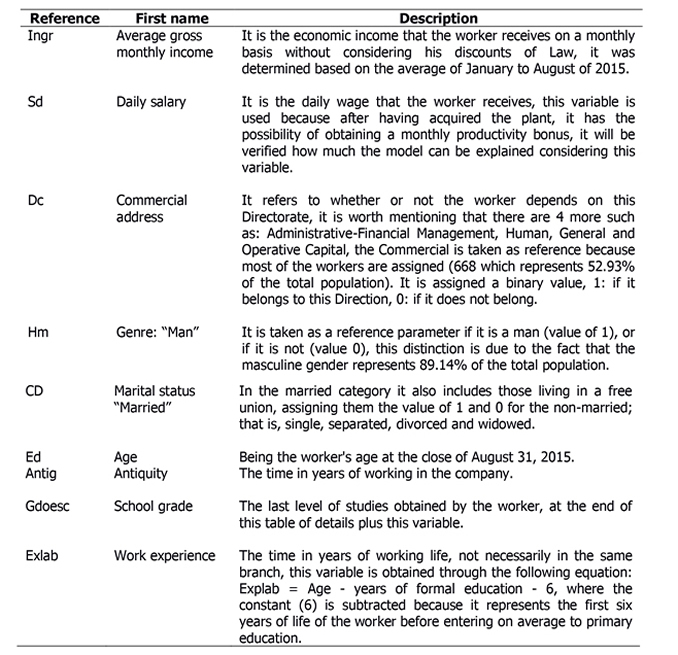
Source: Own elaboration.
Regarding the variable “degree of schooling”, the information obtained does not provide the complete years of study, but the maximum degree of schooling reached, from which a proxy of the years of study will be inferred. The years of schooling will be connoted according to table 3.
Table 3. Accumulated years of study.
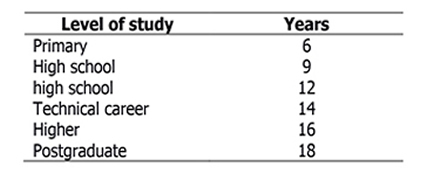
Source: Own elaboration.
4. RESULTS
In this section all the variables that intervene in the application of the model are detailed, to see the impact that each of them has with respect to income. The distribution of the Branches (see table 4) is made up as follows:
Table 4. Branch network in the Mexican Republic.
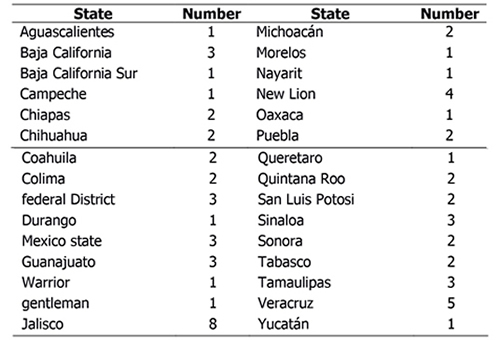
Source: Data obtained from the official website of the company
Refaccionaria, SA de CV, September 2015.
Two distinctions were also made to identify the Corporate (includes all the Departments of offices) and Cedis (includes the Distribution, Maintenance and Guarantees Center).
In the company there are 5 Directorates, which were evaluated according to the Commercial Directorate because they have the largest number of the population in their charge. Table 5 shows the distribution of employees under this heading.
Table 5. Distribution of workers depending on the address to which they belong.

Source: Data obtained from the payroll of August 31, 2015.
Regarding the gross monthly income and the daily salary it is necessary to analyze them under the measures of central tendency (see table 6), to show the panorama prior to the application of the model.
Table 6. Analysis of gross monthly income and daily salary.

Source: Data obtained from the consolidated payroll report of January 01, 2015 as of August 31, 2015.
Table 7. Staff distribution by gender.

Source: Data obtained from the payroll of August 31, 2015.
The independent variable referring to the marital status was also considered to determine the degree of influence with respect to the gross monthly income, being broken down in table 8.
Table 8. Marital status by gender.

Source: Data obtained from the update of personal data of July 2015.
Other additional factors that were considered are the age of the workers and the seniority in the company, which are shown in table 9.
Table 9. Age and seniority of workers years.

Source: Data obtained from the update of personal data of July 2015.
The variable that represents the theory of human capital and the signaling of the markets was determined, being the maximum level of education of the worker (see table 10), with this variable we will confirm if the theoretical is reflected in the practice of the company. The worker’s academic degree and its gender are shown for each level.
Table 10. Academic level by educational level.
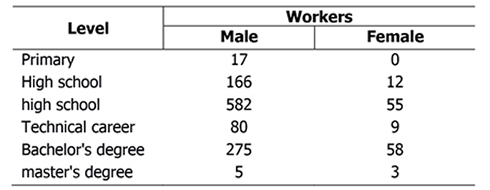
Source: Data obtained from the update of personal data of July 2015.
In the case of the company Refaccionaria, S. A. de C. V., in this area has implemented a policy that as a minimum level of schooling for all positions is the baccalaureate can be truncated or completed, except motorcyclists who still enter secondary level given their profile. Because competition increasingly forces companies to become more professional in order to compete more intensively, having more qualified personnel can be an advantage over this condition.
It is worth mentioning that the company already has 35 years in the market, in its beginnings this variable level of study was not conditioned to the entrance to the company for it was made of personnel without primary and / or secondary education; so that currently has an agreement with the National Institute for Adult Education (INEA) and the National Center for Evaluation of Higher Education, AC, (CENEVAL), so that these workers can accredit their basic level through this institute, thus achieving leveling the corporate level to upper secondary education.
Finally, the factor of work experience was considered, which does not necessarily have to be from the branch of spare parts, the data are shown in table 11.
Table 11. Work experience of workers.
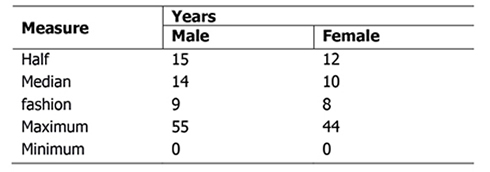
Source: Data obtained from the update of personal data of July 2015.
In this section, the results of the database were analyzed from the aforementioned variables applying as a first instance the multiple linear regression model in a global way (Table 12), the results are shown by sections in order to detail each one of them, in the first, the correlation and determination coefficients are determined.
Regression 1. Application model 1.
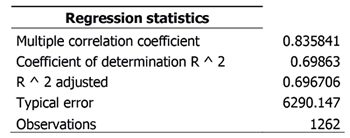
Source: Results obtained from the first regression model.
The first result of the model is that the correlation coefficient is 0.8358 or 83.58%, which indicates that the variables are linearly related or associated with the dependent variable, since a positive number shows that the slope is positive. Regarding the coefficient of determination R^2 mathematically means that the model is adequate to show the interdependence of the variables being in this case 0.6986 or 69.86%. Regarding the results of the coefficients are shown in table 13.
Regression 1.1. Application model 1.

Source: Results obtained from the first regression model.
In this case the probability of interception is 83.50%, leaving the range of less than or equal to 2%, this by the proposed level of confidence of 98%, unable to eliminate it is adjusted to 0 (zero), result a second model with more significant values (table 14).
Regression 2. Application model 2.
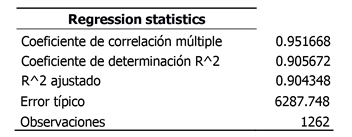
Source: Results obtained from the second regression model.
In this second model the correlation coefficient turns out to be 95.16% and the R^2 in 90.56%, improving the interaction of the variables and making the model mathematically more significant.
When validating the model, the variable “Cd” (table 15), which represents the civil status of the worker “whether or not he is married”, should be eliminated because it is not significant, due to the 98% confidence level.
Regression 2.1. Application model 2.

Source: Results obtained from the second regression model.
Finally, with the validated model, the results are shown in table 16.
Regression 3. Model application 3.
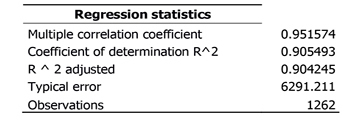
Source: Results obtained from the validated regression model.
There is slight variation of the correlation coefficients and R ^ 2, 95.15% and 90.54% respectively (table 17), this good model to explain the relationships of the variables.
Regression 3.1. Application model 3.

Source: Results obtained from the validated regression model.
The probabilities of the coefficients are less than 2%, so the model is validated. With this we fulfill two of the objectives: To demonstrate the correlation of the variables that are according to income as well as to determine the variables or equation of this relationship:
Yi = β 0 (0) + 49.59 (sd) + 6,241.48 (Dc) + 1,437.88 (Hm) - 2,004.01 (Ed) + 422.33 (Antig) + 2,590.14 (Gdoesc) + 2,10 2.57 (Exlab)
When interpreting the equation, the result is:
The intercept is equal to 0 (zero).
If the daily wage increases one more peso, then the monthly income increases $ 49.59 because the benefits that the company has implemented as well as the proportion of the productivity bonus that it customarily pays to the worker once a month are integrated to it.
If the worker is assigned to the Commercial Directorate, then he obtains $ 6,241.48 pesos more per month, a relation that is consistent since the company is a marketer; more is paid to the commercial staff than to the operative, for example.
If the worker is a man, he earns $ 1,437.88 more per month than a woman, this variable does not necessarily indicate machismo or discrimination, but since it is 89.14% of the total population, it influences the result, as previously mentioned, the woman is already venturing into positions that were customarily held by men.
For one more year of age, the monthly income decreases $ 2,004.01 pesos. This is due to the natural wear and tear of the body that reduces the productivity of the company, this variable is compensated positively with seniority and work experience.
If the worker has one more year of seniority, then the monthly income increases $ 422.33 pesos, in fact the company has implemented benefits that are based on seniority as the permit with pay for the days Holy Thursday, Friday and Saturday for the staff with a minimum of 6 years of seniority or the pension plan where the worker can enter when he has 8 years of seniority in the company, then this variable shows a positive correlation since it is significant for the model.
For each additional year of schooling, the monthly income increases $ 2,590.14 pesos, this variable proves the theory of human capital and indirectly the theory of market signage, being a significant variable with a probability value of 1.33-15, that is to say, below 2% of the established confidence level, with this the other two objectives are met: Identify the benefits that are obtained by investing in human capital and determine if the theoretical elements have applicability in business practice.
Finally, regarding work experience, monthly income increases $ 2,102.57 pesos for each year of experience acquired by the worker.
With the application of this model and its results, the company in question can use them to redesign its compensation system based on these variables that, being significant and based on income, can help the company make fairer payments according to the performance of the employee.
According to the income function, the degree of schooling should be considered as fundamental part of the payment scheme, the theory of human capital, by conceiving education as an investment and by contrasting it with the analyzed data, its applicability is verified currently there is still interest in having more qualified employees, and these skills and abilities can be developed more strongly with formal education, because it also helps the thinking structure.
Employees seek to obtain more credentials or identifiers that help modify their working conditions, either through promotions or increases in the same position. In the analysis company, this part is well-founded because, in the case of administrative positions in corporate and branches, normally in the case of managers, staff with a higher education level are sought, in the case of executives with higher secondary education. or unfinished higher education. That is to say that it considers the signals or credentials that the employees have obtained for their promotions.
It also seeks non-monetary benefits in order to retain their employees, the recognition of the employee of the two-month period, involves the employee in social activities and beneficence to homes, the employee is recognized for his seniority by awarding him a symbolic prize in the events of the end of year. The company seeks to achieve a balance between income, job satisfaction and personal satisfaction.
5. CONCLUSIONS
It is necessary that educational policies in Mexico be reevaluated because the labor market is changing and the level of demand for professionals is becoming more evident, companies demand greater knowledge, specialization, capacity for in-depth analysis, just to mention some factors. Training and academic education is the means to develop these skills, the more training the person has the more skillful they will be and the person will have an advantage over others for insertion in the labor market, as well as the best salary opportunities and consequently the country’s productivity level will improve.
The more “educated” the individual is, the better quality his work is presumed to have and therefore the productivity of the company will benefit. Unfortunately in Mexico the higher educational level does not have the expected impact because, on average, a Master of Administration monthly receives approximately $ 13,603.47 thousand pesos, in the United States, it is almost $ 80,000 Mexican pesos (Rivera, 2009). Some companies believe that hiring a graduate student will be more expensive than one with a lower educational level, it is here that Universities can contribute to change this mentality with greater linking programs, in such a way that the entrepreneur understands that specialization can be an important factor for the development of the company.
Taking into account the variable schooling degree, it is demonstrated that the theory of human capital is applicable in the analyzed company, since it represents 2,590.14 pesos for each year of additional education, making it profitable to invest in education. Through the application of econometric models, quantitative information can be obtained to improve the current processes of the company, or to propose new projects such as a new compensation system that is according to the variables that influence it.
The directors of today should stop making decisions based on empirical thought and use the mathematical tools to better formulate better strategies. The theoretical bases help to base these decisions, which are acquired in the schools mainly, the opening of the managers of the companies is a determining factor, the power to give “permission” to the worker to continue his academic training or to support him economically in his development depends on his idiosyncrasy and business culture, giving greater importance to schooling is a fundamental part of the company’s institutional development.
Opening up to new knowledge, acquiring or developing skills and abilities for better management of processes are imperative for modern management, the transition from the family company to governance becomes more comprehensible or adaptable if the decision maker has degrees of higher education. It is important that the company determines the impact of its qualified employees with higher levels of formal education, look for mechanisms to retain staff, improve their current compensation. Since education is perceived as an investment, it is generally sought to generate future income, as there are no substantial changes in this concept, the talent that will surely help the growth of the company can be let out, as mentioned by Becker.
The employee, when deciding to continue with his academic education, looks for his labor improvements in salary, additional benefits and also the non-monetary one as the satisfaction of having managed to increase his academic level. The labor markets increasingly demanding special skills and abilities, more qualified personnel, pressure the professional to keep themselves more and more updated.
Employees’ job satisfaction not only includes economic remuneration but also those that help balance work and personal life, an effective compensation system must consider the objectives sought in this area, in order to retain its employees. Insert the level of schooling in its payment scheme will cause the staff to be interested in searching for these benefits and to return to the classroom, the new knowledge helps to modify behaviors and give a broader vision that promotes a healthy work culture and, consequently, the level of productivity of the company increases.
In general terms, education offers improvements in personal, social and work conditions, getting more and more people interested in continuing their studies will lead to improvements, more educated people, a safer society, productive companies and a nation with accelerated growth.
Therefore, a restructuring in the compensation system of the company under study is proposed, where the variable degree of education is considered above all, through a scale plan and levels, where the higher academic level the worker obtains, the more they can access salary improvements, positions of greater rank and responsibilities, as well as additional benefits such as support in the payment of fees for their children (if they have them) or access to a vehicle owned by the company, in such a way that the professionalization of the employee is encouraged because, the more educated employees are, the better results the organization will obtain, the productivity and profitability of the business will increase by having more qualified personnel.
The most suitable variables to be considered in the compensation structure of the company “Spare Parts Store, SA of CV” are: the daily salary, seniority in the company, degree of schooling and work experience, in such a way that the payment system is in line with employee productivity.
Implement a scholarship program to encourage employees to continue with their academic training that is oriented to the company’s business, or through agreements with private universities that will help the company to be more efficient. Because education is relevant and, when analyzing it from the Human Capital Theory perspective, we realize that the level of education is related to productivity, in the additional classrooms to transmit knowledge, help to modify thought structures, create more conscious citizens and entrepreneurs or collaborators with greater vision.
REFERENCES
1. Anderson, D.; Sweeney, D., & Williams, T. (2008). Estadística para administración y economía. México: Cengage Learning.
2. Angulo Pico, G. M.; Quejada Pérez, R., & Yánez Contreras, M. (2012). Educación, mercado de trabajo y satisfacción laboral: el problema de las teorías del capital humano y señalización de mercado. Revista de la educación superior, 41(163), 51-66. Recuperado de http://www.scielo.org.mx/scielo.php?script=sci_arttext&pid=S0185-27602012000300002&lng=es&tlng=es.
3. Becker Stanley, G. (1987). Teoría económica. México: Fondo de Cultura Económica.
4. Becker Stanley, G. (1993). Human capital: A theoretical and empirical analysis, with special reference to education. Estados Unidos: The National Bureau of Economic Research.
5. Becker, G. (2002). La economía cotidiana. México: Editorial Planeta Mexicana.
6. Cardona Acevedo, M.; Montes Gutiérrez, I. C.; Vásquez Maya, J. J.; Villegas González, M. N., & Brito Mejía, T. (2007). Capital humano: Una mirada desde la educación y la experiencia laboral. Medellín, Colombia: Universidad EAFIT. Recuperado de http://publicaciones.eafit.edu.co/index.php/cuadernos-investigacion/article/view/1287/1166.
7. Castellar, C., & Uribe, J. (2004). Capital humano y señalización: evidencia para el área metropolitana de Cali, 1988-2000. Revista Sociedad y Economía, 6. Recuperado de http://sociedadyeconomia.univalle.edu.co/index.php/sye/article/viewFile/179/186.
8. Díaz de Iparraguirre, A. M. (2009). La gestión compartida Universidad-Empresa en la formación de capital humano, su relación con la promoción de la competitividad y el desarrollo sostenible. (Tesis de Doctorado). Universidad Nacional Experimental, Caracas, Venezuela. Recuperado de http://www.eumed.net/tesis-doctorales/2009/amdi/Teoria%20del%20Capital%20Humano.htm
9. Kazmier, L., & Díaz Mata, A. (2013). Estadística aplicada a la administración y la economía. México: Mc Graw Hill Interamericana.
10. Garrido Trejo, C. (2007). La educación desde la teoría del capital humano y el otro. Educere, 11(36), 73-80. Recuperado de http://www.redalyc.org/articulo.oa?id=35617701010
11. Johnson, H. (1975). On Economics and Society. Chicago: University of Chicago Prees.
12. Iglesias Garrido, J. (2005). Capital humano y señalización. Recuperado de http://dep-economia-aplicada.uab.cat/secretaria/docrecerca/jiglesias.pdf
13. Levin, R., & Rubin, D. (2010). Estadística para administración y economía. Estado de México: Pearson. Levine, D.; Krehbiel, T., & Berenson, M. (2006). Estadísticas para administración. Estado de México: Prentice Hall.
14. Morales-Ramos, E. (2011). Los rendimientos de la educación en México. Banco de México, Working Paper, nº 2011-07. Recuperado de http://www.banxico.org.mx/publicaciones-y-discursos/publicaciones/documentos-de-investigacion/banxico/%7BE6CBA842-39BD-6251-B12C-6F55EB399EF7%7D.pdf
15. OCDE (1998). Measuring what people know: Human capital for the knowledge economy. Francia: OECD Publications.
16. ONU (1998). Información general. México: Centro de información de la Naciones Unidas.
17. Ontiveros Jiménez, M. (2007). El mercado laboral como vínculo entre la inversión en educación y su rendimiento. Revista Latinoamericana de Estudios Educativos (México), XXXVII(3-4), 239-268. Recuperado de http://www.redalyc.org/articulo.oa?id=27011410010
18. Rojas, M.; Angulo, H., & Velázquez, I. (2000). Rentabilidad de la inversión en capital humano en México. Revista Nueva época (México), IX(2), Recuperado de http://www.economiamexicana.cide.edu/num_anteriores/IX-2/01_MARIANO_ROJAS_113-142.pdf
19. Ruiz Duran, C. (1998). El reto de la educación Superior en la sociedad del conocimiento. México: ANUIES.
20. Uribe, J. (2006). Ensayos de economía aplicada al mercado laboral. Cali, Colombia: Universidad del Valle.
21. Villalobos Monroy, G., & Pedroza Flores, R. (2009). Perspectiva de la Teoría del Capital Humano acerca de la relación entre educación y desarrollo económico. Tiempo de Educar, 10(20), 273-306. Recuperado de http://www.redalyc.org/articulo.oa?id=31112987002
22. Zamudio, A., & Bracho, T. (1992). Rendimientos económicos a la escolaridad: discusión teórica y métodos de estimación. División de Estudios Políticos y de Economía, 30. México: CIDE.
AUTHORS
Javier Jiménez Rodríguez. Graduated from the Master in Business Administration, Recognition from CONACYT. CUCEA / UDG.
javijiro@icloud.com
Rosario Cota Yáñez. Professor-researcher at the Department of Regional Studies at the University of Guadalajara (DER/INESER). Degree in economics, Regional Development teacher specializing in Public Policy, PhD in Social Sciences specializing in Regional Development. It belongs to the academic squad Restructuring and Local Studies UDG 643.
Macotaya@cucea.udg.mx
Mailing Address: Periférico Norte 799, Módulo M. 2do. Nivel, Núcleo Universitario Los Belenes, Departamento de Estudios Regionales (DER-INESER)
CP. 45100, Zapopan, Jalisco, México.
Phone: 37703404 and 37703300 ext. 25253